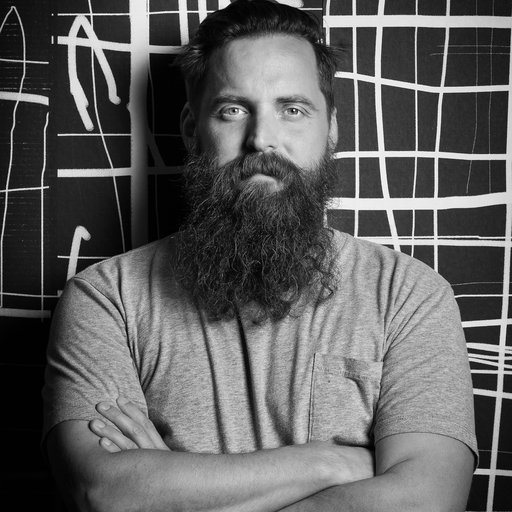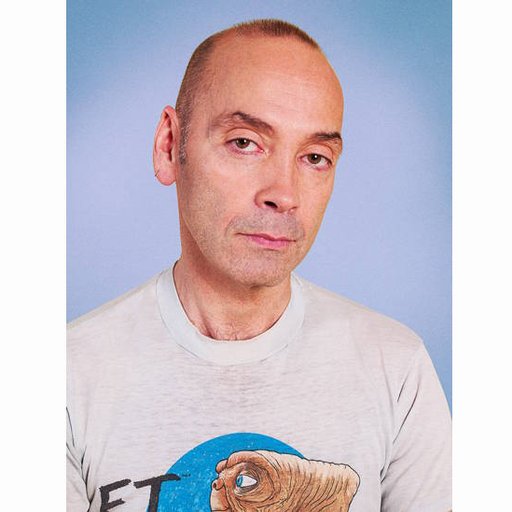Roger Brown
Known best for his politically wry faux-naif paintings, Roger Brown is associated with the Chicago Imagists who were trained at the Chicago Institute of Art during the late 1960s. This informal group of artists rejected the Neo-Expressionist abstract painting trend dominant in New York, in favor of humorous–often surreal–representational depictions of vernacular culture. Many, including Brown, were taught by Ray Yoshita who encouraged an appreciation of self-taught artists and comic art. Throughout Brown’s oeuvre, which included sculptures, painted found objects, and large-scale public murals, the artist returned to the theme of architecture. Presented in a flattened cartoon style composed of brightly colored patterned shapes, these scenes are often harmonious despite unnerving content–buildings bending over or breaking apart seem just as animate as the black silhouettes of figures seen in the windows. Brown found formal inspiration from his extensive personal collection which included flea market finds, folk and tribal art, furniture, and a treasured Ford Mustang. He chose subject matter that addressed current events directly, offering his view on widely publicized tragedies such as the
mass
suicides at Jonestown, the O. J. Simpson trial, the Gulf War, as wells as more personal injustices such as homosexual discrimination during the HIV/AIDS epidemic. …
Known best for his politically wry faux-naif paintings, Roger Brown is associated with the Chicago Imagists who were trained at the Chicago Institute of Art during the late 1960s. This informal group of artists rejected the Neo-Expressionist abstract painting trend dominant in New York, in favor of humorous–often surreal–representational depictions of vernacular culture. Many, including Brown, were taught by Ray Yoshita who encouraged an appreciation of self-taught artists and comic art. Throughout Brown’s oeuvre, which included sculptures, painted found objects, and large-scale public murals, the artist returned to the theme of architecture. Presented in a flattened cartoon style composed of brightly colored patterned shapes, these scenes are often harmonious despite unnerving content–buildings bending over or breaking apart seem just as animate as the black silhouettes of figures seen in the windows. Brown found formal inspiration from his extensive personal collection which included flea market finds, folk and tribal art, furniture, and a treasured Ford Mustang. He chose subject matter that addressed current events directly, offering his view on widely publicized tragedies such as the
mass
suicides at Jonestown, the O. J. Simpson trial, the Gulf War, as wells as more personal injustices such as homosexual discrimination during the HIV/AIDS epidemic.
Solo exhibitions of Brown’s work have been presented at institutions such as Art Institute of Chicago, Hyde Park Art Center in Chicago, Springfield Art Museum, Jules Collins Smith Museum of Fine Art at Auburn University in Alabama, Katzen Arts Center at American University in Washington, DC, and Ogden Museum of Southern Art in New Orleans, New Museum in New York, and Scottish National Gallery of Modern Art in Edinburgh. His work has also been included in group exhibitions at New York’s Museum of Modern Art, Chicago’s Museum of Contemporary Art, Honolulu Museum of Art, Smithsonian American Art Museum in Washington DC, and Hessel Museum of Art at Bard College in Annandale-on-Hudson, among many others.
Art Institute of Chicago, Chicago, IL
Museum of Contemporary Art, Chicago, IL
David and Alfred Smart Museum at the University of Chicago, Chicago, IL
Chicago History Museum, Chicago, IL
Mary and Leigh Block Gallery at Northwestern University, Chicago, IL
Whitney Museum of American Art, New York, NY
Museum of Modern Art, New York, NY
Metropolitan Museum of Art, New York, NY
Dallas Museum of Art, Dallas, TX
Corcoran Gallery of Art, Washington, DC
Smithsonian American Art Museum, Washington, DC
Museum of Fine Arts, Boston, MA
Los Angeles County Museum of Art, Los Angeles, CA
Scottish National Gallery of Modern Art, Edinburgh, UK
Museum Moderner Kunst, Vienna, Austria
DC Moore Gallery, New York, NY






